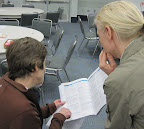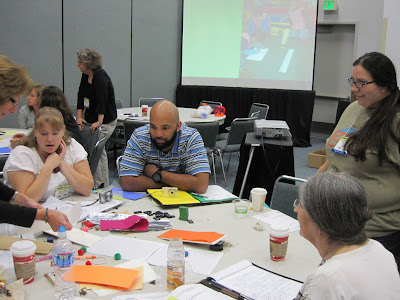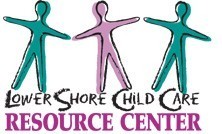NAEYC post conference update: science was there
By Peggy Ashbrook
Posted on 2010-11-08
 From beginning to end, the National Association for the Education of Young Children 2010 annual conference in collaboration with National Black Child Development Institute offered meaty sessions on early childhood science curriculum. Of course, science curriculum goes nowhere without a good foundation in the early childhood classroom environment, social-emotional development, circle time, understanding and supporting diversity and equity, collaborating with families, and professional development, to name some of the many other session topics.
From beginning to end, the National Association for the Education of Young Children 2010 annual conference in collaboration with National Black Child Development Institute offered meaty sessions on early childhood science curriculum. Of course, science curriculum goes nowhere without a good foundation in the early childhood classroom environment, social-emotional development, circle time, understanding and supporting diversity and equity, collaborating with families, and professional development, to name some of the many other session topics.
 The first session I attended was a treat, “Big ideas for little brains: Teaching fundamentals of physical science to 4-year-olds” presented by a highly knowledgeable, energized, and friendly group of researchers and educators who obviously enjoyed their productive collaboration: Dr. Brian Anderson, Dr. Mary Hobbs, Dr. Robert Williams, Dr. Elizabeth Sherwood, (the latter two are also co-authors of The Preschool Scientist: Using learning centers to discover and explore science, (2010, Gryphon House), Sandy Martinez and Montserrat Garibay, Bi-lingual Pre-kindergarten teachers from the Lucy Read Pre-kindergarten Demonstration School in the Austin Texas Independent School District, and Gail Laubenthal, Pre-kindergarten teacher researcher and “Technoscientist” from the Sanchez Elementary School, also in the Austin ISD. Gail told us that using technology in her classroom might include using the classroom desktop computers or the computers in the computer lab, iPod Touches, iPods, digital microscopes, digital cameras, flip video cameras, a Mimio Interactive System, or the Innovation Station! Ms. Laubenthal is also known as the Ladybugs blogger, where you can see what her students are investigating.
The first session I attended was a treat, “Big ideas for little brains: Teaching fundamentals of physical science to 4-year-olds” presented by a highly knowledgeable, energized, and friendly group of researchers and educators who obviously enjoyed their productive collaboration: Dr. Brian Anderson, Dr. Mary Hobbs, Dr. Robert Williams, Dr. Elizabeth Sherwood, (the latter two are also co-authors of The Preschool Scientist: Using learning centers to discover and explore science, (2010, Gryphon House), Sandy Martinez and Montserrat Garibay, Bi-lingual Pre-kindergarten teachers from the Lucy Read Pre-kindergarten Demonstration School in the Austin Texas Independent School District, and Gail Laubenthal, Pre-kindergarten teacher researcher and “Technoscientist” from the Sanchez Elementary School, also in the Austin ISD. Gail told us that using technology in her classroom might include using the classroom desktop computers or the computers in the computer lab, iPod Touches, iPods, digital microscopes, digital cameras, flip video cameras, a Mimio Interactive System, or the Innovation Station! Ms. Laubenthal is also known as the Ladybugs blogger, where you can see what her students are investigating.
Their project, Building BLOCKS for Science, is supported by the National Science Foundation and the Texas Center for Science and Mathematics Education. I was worried that a 4-hour session would be too long for me but time flew by as we heard about the professional development they were providing as part of their project, and experienced some exploration ourselves. The challenging opening was to get in a small group and sort a small bag of objects, list the ways each group sorted the objects, and then sort again, and again, in yet other ways. How many criteria can you sort by?—size, material, color, texture, purpose of use, weight…I think there were five or six additional categories and we could have continued. Enthusiastic and deft teaching by Ms. Martinez and Ms. Garibay led us in examining the properties of matter with ramps and various objects, wind-up toys, and other objects in motion. We didn’t have enough time to find out what Ms. Laubenthal’s role is as “technoscientist” but her blog has some details.
“Early Education Issue Forum: A Framework that Works – Implementing Successful PreK-3rd Strategies”, was a thought-provoking presentation by Lisa Guernsey, Director of New America’s Early Education Initiative and author of Into the Minds of Babes: How Screen Time Affects Children From Birth to Age 5, (Basic Books, 2007), and Dr. Iheoma Iruka, research Investigator at the Frank Porter Graham Child Development Institute who is working on their FirstSchool preK-3rd initiative to move education systems toward a seamless approach for children ages 3 to 8.
What connections exist in your community between prekindergarten and kindergarten teachers? Depending on the program, the differences in pay scale and expectation of higher education can be huge but that shouldn’t stop us from meeting to better integrate our curriculums to make children’s transition to kindergarten easier and more informative for the next teacher. The presenters urged us to move our communities to establish preK-3 alignment of curriculum to sustain the gains we make in preschool.
Dr. Michaela Cole, Assistant Professor of Education, Our Lady of the Lake University held a discussion in the Learning Galleria about her evolving project, “Viewing nature through children’s eyes: Results from a photo elicitation project” in exploring children’s discovery of patterns and shadows in natural settings using photography. In one class she studied, the students’ transition to kindergarten was made easier by another photography project in which the mothers were given cameras to take pictures of their child to explain who their child is, to the upcoming kindergarten teacher. The pictures were even more important for children whose teachers and mothers did not share a language. Such a beautiful idea, one that supports the goals described by Guernsey and Iruka.
Marie Faust Evitt and Tim Dobbins, teachers from Mountain View, CA, illustrated their session, “Thinking BIG, learning BIG: Connecting science, math, literacy, and language” with a slide show teaching us how to use inquiry-based science to bring math, literacy, and art into an early childhood day in many fun, BIG –because children like that–ways.

In her session, “STEM (science, technology, engineering, and math) comes to preschool: Implementing an integrated science and mathematics curriculum in an inclusive inner-city program”, Dr. Sally Moomaw, assistant professor in Early Childhood Education and Special Education at the University of Cincinnati showed us how STEM projects using pendulums, easy to manipulate ramps, and pattern-recognition using recorded bird calls in stuffed toy birds lead to increases in language development, reasoning, and cognitive development in the inclusive Cincinnati public school classroom of preschool special education teacher Jaumall Davis. (See their article in the September 2010 Young Children.) Her obvious enjoyment in teaching (children and adults) and her sensitive attention to the nuances of communication by children with special needs reminds us that all children need STEM activities. (Download their session PowerPoint posted on the NAEYC Precis Abstract Management list at the bottom of the session description.)
 Up to the last minute, the NAEYC annual conference sessions were communicating effective ways to bring science into early childhood classrooms. In “Creating a high-quality, low-cost mobile science museum for your program or community”, Karen Goldman-Karten and Amy Doerzbach of the The Lower Shore Child Care Resource Center in Salisbury, MD, told and showed video of how they went after funding to create a mobile science museum to take engaging activities to the day care programs, preschools, and child care in family homes. Flip-flop phone, making and comparing footprints, and bubbles of many sizes were among the materials that teachers and children freely explored, observed, wondered and collected data about. A professional development component supports providers and teachers as they implement science inquiry with their children in their programs. Karen and Amy urged us to start small but think big and don’t be afraid to approach our local banks for small grants. All children should have access to science inquiry.
Up to the last minute, the NAEYC annual conference sessions were communicating effective ways to bring science into early childhood classrooms. In “Creating a high-quality, low-cost mobile science museum for your program or community”, Karen Goldman-Karten and Amy Doerzbach of the The Lower Shore Child Care Resource Center in Salisbury, MD, told and showed video of how they went after funding to create a mobile science museum to take engaging activities to the day care programs, preschools, and child care in family homes. Flip-flop phone, making and comparing footprints, and bubbles of many sizes were among the materials that teachers and children freely explored, observed, wondered and collected data about. A professional development component supports providers and teachers as they implement science inquiry with their children in their programs. Karen and Amy urged us to start small but think big and don’t be afraid to approach our local banks for small grants. All children should have access to science inquiry.
Now it’s your turn to share about your session or one that was inspiring to you. The NAEYC Precis Abstract Management list will have links to session handouts up for a while—search for the session, click on the title, and scroll down to the bottom of the new session-details window that opens to see if any handouts have been posted.
My handouts will be up soon,
Peggy
Disclaimer: The views expressed in this blog post are those of the author(s) and do not necessarily reflect the official position of the National Science Teaching Association (NSTA).


